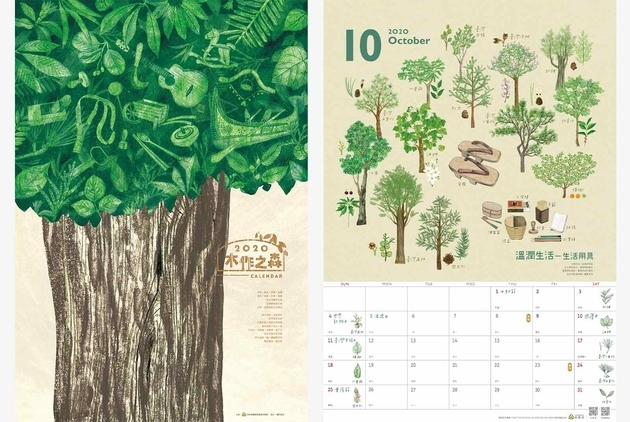Hot Ticket: The Forestry Bureau’s Secret to Making Best-selling Calendars

Source:The Forestry Bureau
For the 2020 calendar, Forest of Woodwork, why did they choose a more subdued approach?
Views
Hot Ticket: The Forestry Bureau’s Secret to Making Best-selling Calendars
By Monica Wangweb only
Tweaks to a calendar have lifted the veil of mystery from the Forestry Bureau and taken it to the people, winning over fans of all ages, and even igniting a sea change in the aesthetics of government agency communications. But aren’t these hot-selling calendars merely cute and visually pleasing? For the 2020 calendar, Forest of Woodwork, why did they choose a more subdued approach? In the aftermath of the leopard cat kerfuffle, what insights can the success of the Forestry Bureau’s calendars provide?
The year is not even over, yet news of calendar pre-sales and fundraising is all over social media platforms. Among them is the offering from the Taiwan Centers for Disease Control, which uses personification for its newest calendar.
The Forestry Bureau, which stirred up this frenzy to begin with, has been oddly quiet, only announcing pre-sales in mid-November.
“This fruit isn’t shaped right.” Just one week before the announcement, the Forestry Bureau, graphic design company, and consultant were still going back and forth proofing manuscripts and letters, and fussing over the miniscule buds, veins, and blossoms on over 100 trees as part of next year’s Forest of Woodwork theme.
Last year, the Forestry Bureau teamed up with Seedesign to completely rework the calendar given out regularly to associate business units. The hand-illustrated calendar, titled Forest of Food and Drink, was wildly popular across the entire Greater China region. (Read: Unexpected Buzz with an Artsy Calendar)
 Forest of Food and Drink calendar (Source: The Forestry Bureau)
Forest of Food and Drink calendar (Source: The Forestry Bureau)
In addition to the 20,000 copies given out in the first printing, an additional 8,000-copy run of last year’s Satoyama Animals in Taiwan was printed for sale via national platforms. That run sold out immediately, resulting in many posters on Facebook missing the boat.
“A while back we got a message from someone asking if there were any calendars left with pages torn out, as he wanted to collect them,” chuckles Lu Ying-hsiu, section chief of the Forestry Bureau’s Forest Management Section. In response to the overwhelming demand from friends and family, and given the limited quantity available, colleagues at the Forestry Bureau also got in on the frenzy and pre-ordered calendars. Wherever Forest Bureau Director-General Lin Hwa-Ching went to attend meetings or give speeches, he was mobbed by teachers afterwards.
“We knew it would be popular, but we never thought it would have such a huge impact,” says Lin, who breathed a sigh of relief once he saw the response to on-line pre-sales for this year’s calendar. This is because the Forest of Woodwork theme is the bureau’s biggest undertaking, and something that he had wanted to do as long as three years ago to promote reform, yet not such an easy task to put into practice.
 Forest of Woodwork calendar. (Source: The Forestry Bureau)
Forest of Woodwork calendar. (Source: The Forestry Bureau)
Translating Sweeping Research and Surveys Into Design Themes
The first year, the Forest of Food and Drink’s herbs theme was friendly and visually varied. The second year, the cuteness and vitality of the Satoyama Animals theme goes without saying. Each has their fans, while in contrast trees simply stand around quietly. Accordingly, if it had followed the same visual guidelines and arrangements as the previous two years, each month’s illustrations would be too similar to one another. Plus, all the surrounding wood growth must be tied together.
 Satoyama Animals in Taiwan calendar. (Source: The Forestry Bureau)
Satoyama Animals in Taiwan calendar. (Source: The Forestry Bureau)
The Forestry Bureau avoided resorting to gimmicks, opting for vertical orientation and illustrative breakdowns. During a working group meeting this past February, Lin Hwa-ching asked colleagues in the Reforestation Department to undertake a sweeping survey of the various tree species used to make various wood products related to daily life, including kitchenware, agricultural tools, furniture, tools for weights and measures, children’s toys, and building construction. After exhaustive evaluation, re-evaluation, and summary to eliminate repetition, the monthly themes we see today finally resulted.
Have you read?
♦ The 23-Year-Old Girl Who Put Pingtung Back on the Map
♦ Taiwan's Global Noah’s Ark of Plants
♦ The Best Hiking Trails in Taiwan
“While compiling the calendar, we saw the wisdom of those who came before who us, took what was available and utilized wood with different textures and personalities. For instance, the skiffs of Orchid Island are constructed from different types of wood, and only wood that is straight and sturdy enough is suitable for a scale to make precise measurements. This induces reflection on which materials how now replace these things, and how we can reduce the consumption of resources,” relates Lin Hwa-ching.
 Lin Hwa-ching, Director-General of the Forestry Bureau, spearheaded the production of the lucrative annual calendar, providing considerable inspiration to corporations and government agencies. (Photo by Kuo-Tai Liu/CW)
Lin Hwa-ching, Director-General of the Forestry Bureau, spearheaded the production of the lucrative annual calendar, providing considerable inspiration to corporations and government agencies. (Photo by Kuo-Tai Liu/CW)
With artists limited to drawing one and a-half trees per day, Seeddesign adopted two techniques, rendering objects in soft brushstrokes and using uniform green for trees, augmented by a few details like added fruits and flowers. Leaf veins were added to blank spaces on the calendar, and for the notebook a tree ring cross section complements various objects.
Normally grand, towering trees are scaled down to fit alongside such nostalgic items as children’s tops, camping gear, temples, or the unique plank-sectioned boats of Orchid Island. With no overt attention-grabbers, the design is not immediately pleasing or cute, yet it exudes the calm, tranquility of nature’s protective qualities, bringing out soothing feelings associated with hand-crafted wood items.
 Forest of Woodwork notebook (Source: The Forestry Bureau)
Forest of Woodwork notebook (Source: The Forestry Bureau)
Conveying Factual Information without Preaching
“We published two best-selling books two years in a row. What about book number three? We hope to show everyone both the forest and the trees this year. Perhaps it’s not as outwardly appealing, but it’s certainly more far-reaching,” relates Kan Ko-ping, director of Seeddesign.
Wu Han-chung, who oversaw the 2016 Taipei Design Capital as executive director, and was lead designer for the 2018 Taichung Flora Expo, often cites the cases of the Forestry Bureau’s collaboration with Seeddesign on the calendar and train decoration with Satoyama critters when discussing curriculum incorporating design aesthetics with the heads of government agencies at the county and city level.
He observes that the recent leopard cat train car design controversy provided food for thought for the Forestry Bureau in its calendar undertaking. “How many dozens, even hundreds of revisions does it take to get a design aesthetically right, combining various professions and strengths to nail it down.”
“The Forestry Bureau employed a light-hearted, sweet approach that refrained from preaching, consistent with its mission of conveying knowledge, and never just pretending to be cute and pretty,” relates Kan Ko-ping with an awkward laugh. After three years of working with the Forestry Bureau, Seeddesign is accustomed to holding the line for scholars as well as constant back-and-forth on proofreading.
On this occasion, in the effort to inject more life into the pages, major revisions were undertaken during the post-production period. In response to the public’s feedback and demands expressed over the past two years, the Forestry Bureau this year introduced desktop versions featuring the themes of all three years, with a Taiwanese camphor tree base. Additionally, to mark Year 109 of the Republic of China, a poster featuring 109 endemic Taiwanese trees was released. Each galley proof underwent three to four revisions.
 Poster of 109 endemic Taiwanese tree species. (Source: The Forestry Bureau)
Poster of 109 endemic Taiwanese tree species. (Source: The Forestry Bureau)
Integrating Environmental Consciousness into Storytelling
An increasing number of government agencies are employing design aesthetics to communicate with the public, which Kan Ko-ping agrees is a good thing. However, the issue is not just making animals a topic of discussion, but how to tell a good story while also considering the environment.
Like the films of Hayao Miyazaki, due to a complete investment in the concept of co-existence with the satoyama critters, the appearance of every living thing signifies a certain meaning rather than simply coming from out of the blue. That makes it more fun and more powerful to Kan.
Wu Han-chung further notes that, apart from spot-on design aesthetics, the Forestry Bureau calendar can provide enterprises and public agencies with greater insight. For instance, general brand marketing that gains entry into the public’s lives through calendars and railways has been successful, as well as how to incorporate business through design aesthetics and impact people’s perceptions to bring about changes in an organizational culture and atmosphere.
“The Forestry Bureau is doing the same thing it’s always done, only before it was too far removed from the public. Thanks to the calendars and railways, everyone now knows that the Forestry Bureau is all about. With public acceptance, staff members become even more passionate about their respective roles, discovering that design can motivate a corporation or organization’s culture,” explains Wu Han-chung. “Image makeovers are fine, but the key is not to stay put at the level of promotion, but changing everyone’s awareness and experiences.”.
From awareness to action, how can the Forestry Bureau transform communications regarding such areas as conservation and fire prevention? The road ahead is long, but the anticipation over the annual calendar has established an ideal foundation for their efforts.
Translated by David Toman
Edited by TC Lin, Sharon Tseng












